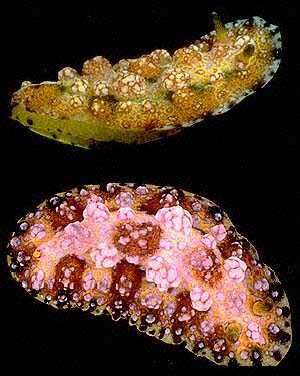
Phyllidiopsis cardinalis
Bergh, 1875
Order: NUDIBRANCHIA
Suborder: DORIDINA
Family: Phyllidiidae
DISTRIBUTION
Throughout the tropical Indo-West Pacific
PHOTO
UPPER: Oronte Point, Guam, 29m, April 1984. Dorsolateral view of 25mm spm, Brunckhorst, 1993: Plate 7F.
LOWER: Bile Bay, Guam, 2m, June 1973. Dorsal view of 20mm spm, Brunckhorst, 1993: Plate 7E.
PHOTOS: C. Carlson & P. Hoff.
Notes compiled from Brunckhorst, 1993:
Phyllidiopsis cardinalis has a complex, multicoloured dorsum that is characteristic of the species. The median tubercles are very large and globose. Small, pale yellow, rounded tubercles arise on the large basal tubercle (i.e., multicompound). A network of reddish-orange veins runs between the pale yellow tubercles. The ventral yellow coloration is also characteristic. The side of the yellow foot has dark spots and the fused oral tentacles have a very broad base and deep, long grooves.
The unique and complex coloration render P. cardinalis totally different from any other known phyllidiid species. In external appearance, it is unlike any of its congeners which possess either pink, white or blue coloration and which lack yellow coloration ventrally. Phyllidia ocellata has gold-yellow coloration but none of the other colours of the present species.
Reference:
• Brunckhorst, D.J. (1993) The systematics and phylogeny of Phyllidiid Nudibranchs (Doridoidea). Records of the Australian Museum, Supplement 16: 1-107.
Rudman, W.B., 1999 (August 1) Phyllidiopsis cardinalis Bergh, 1875. [In] Sea Slug Forum. Australian Museum, Sydney. Available from http://www.seaslugforum.net/find/phylcard
Related messages
Egg ribbon of Phyllidiopsis cardinalis [2]
September 8, 2008
From: Gary Cobb
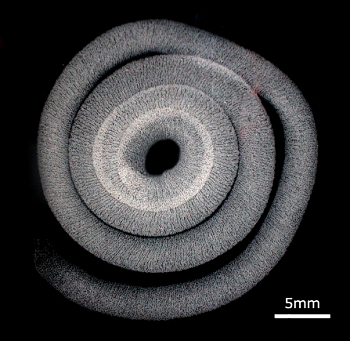
Concerning message #21871:
Hi Bill and everyone,
Here are some more photos of the egg mass of Phyllidiopsis cardinalis.
Locality: Mooloolaba, Sunshine Coast, 14 m, Queensland, Australia, Pacific Ocean, 07 September 2008, Subtidal. Length of animal: 55 mm. Photographer: Gary Cobb.
Cheers
Gary Cobb
gary@nudibranch.com.au
Cobb, G.C., 2008 (Sep 8) Egg ribbon of Phyllidiopsis cardinalis [2]. [Message in] Sea Slug Forum. Australian Museum, Sydney. Available from http://www.seaslugforum.net/find/21872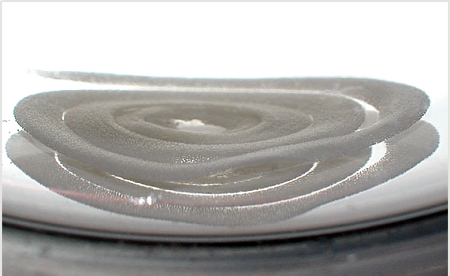
Thanks Gary,
Am I correct in assuming the upper photo - on black background - is taken through the glass so we are seeing a ventral [underside] view, while the lower photo is a view of the upper surface? I need to confirm this so we know if the ribbon is a clockwise or anticlockwise spiral.
Also has the ribbon been lifted off the glass in the lower photo? I would assume all the egg ribbon is stuck down but in this photo the outer whorl doesn't seem to be attached. Is this an optical illusion?
Best wishes,
Bill Rudman
Egg ribbon of Phyllidiopsis cardinalis [1]
September 8, 2008
From: Gary Cobb
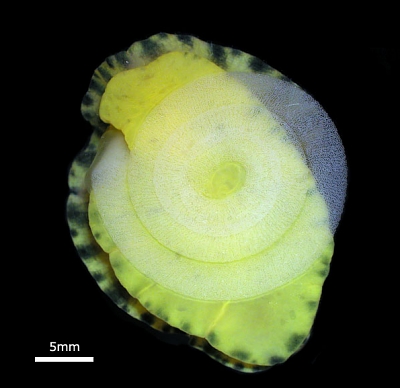
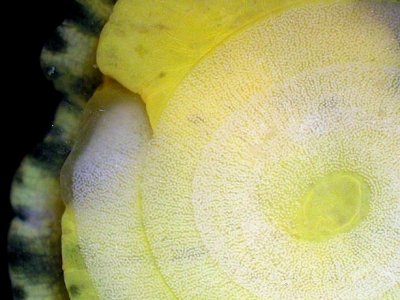
Hi Bill and everyone!
Magic happens! Here are some photos of Phyllidiopsis cardinalis laying eggs. There is a scale bar on one photo. The animal actually turn side-wise while laying it's eggs. The mass is only about 1 mm or an egg thick. [see also message #21872]
Locality: Mooloolaba, Sunshine Coast, 14 m, Queensland, Australia, Pacific Ocean, 07 September 2008, Subtidal. Length of animal: 55 mm. Photographer: Gary Cobb.
Cheers
Gary Cobb
gary@nudibranch.com.au
Cobb, G.C., 2008 (Sep 8) Egg ribbon of Phyllidiopsis cardinalis [1]. [Message in] Sea Slug Forum. Australian Museum, Sydney. Available from http://www.seaslugforum.net/find/21871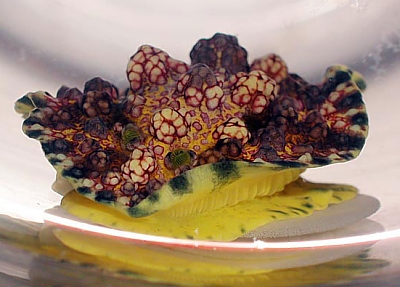
Dear Gary,
Thanks for sharing these photos. You are evidently blessed with magic - usually when I have nudibranchs laying eggs in aquaria they use the corners, or other awkward places, making photography impossible.
Best wishes,
Bill Rudman
Phyllidiopsis cardinalis from Reunion Island
November 7, 2006
From: Hugues Flodrops
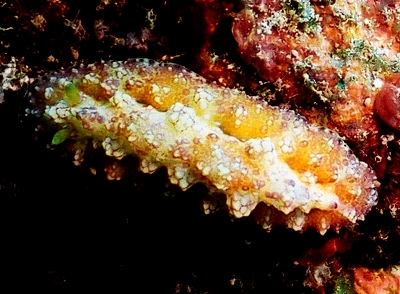
Concerning message #18064:
Dear Bill,
I found this slug few years ago at Tour de Boucan.
Locality: Tour de Boucan, 15 metres, Reunion Island, Indian Ocean, 3 Aout 2003. Length: 40 mm. Photographer: Hugues Flodrops.
I think it is a Phyllidiopsis cardinalis with another pattern. The specimen spotted by Y. Coze [#11574] is more orange. Here, the rhinophores are deep yellow in colour with the outer edge of the lamellae olive.
Thank's for your confirmation.
Best regards.
Hugues.
hugues.flodrops@wanadoo.fr
Flodrops.H, 2006 (Nov 7) Phyllidiopsis cardinalis from Reunion Island. [Message in] Sea Slug Forum. Australian Museum, Sydney. Available from http://www.seaslugforum.net/find/18145Dear Hugues,
Yes this is just a colour form on P. cardinalis.
Best wishes,
Bill Rudman
Phyllidiopsis cardinalis from East Timor
July 10, 2006
From: Nick Hobgood
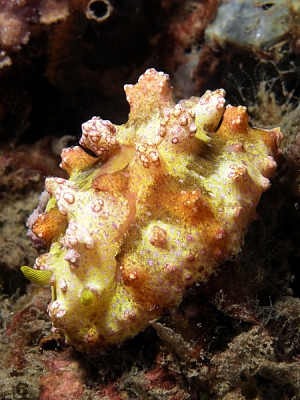
Bill,
Can you please help us with the ID of this slug. This is the first time we've seen this one here.
Locality: Town, 18 meters, East Timor, Banda, 08 July 2006, Sandy bottom. Length: 6 cm . Photographer: Nick Hobgood.
Thanks
Nick Hobgood
nick.hobgood@mac.com
Hobgood, N., 2006 (Jul 10) Phyllidiopsis cardinalis from East Timor. [Message in] Sea Slug Forum. Australian Museum, Sydney. Available from http://www.seaslugforum.net/find/17090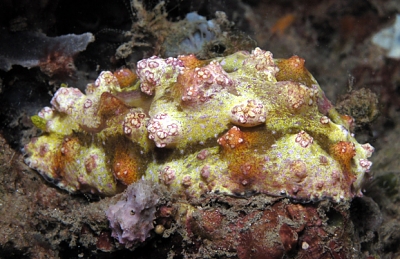
Dear Nick,
I am glad to see the recent troubles haven't caused you to leave East Timor. This is Phyllidiopsis cardinalis. I don't know if you picked it up or not, but it is bright yellow underneath. It would be interesting to know something about the chemistry of this species as it is one of the few species of the Phyllidiidae which has a cryptic colouration. As you will know, most species of Phyllidia and Phyllidiella are blatantly coloured and are often the only nudibranchs out in the open during the day, suggesting they have no need to hide from hungry fish. We consider that the main reason for this is the extremely distasteful chemicals they store in their skin, and obtain from the sponges they feed on.
It would be very interesting to know what sponge this species feeds on, and whether it, or P. cardinalis, has a store of distasteful chemicals.
Best wishes,
Bill Rudman
Phyllidiopsis cardinalis from South Africa
June 26, 2006
From: Riaan Marx
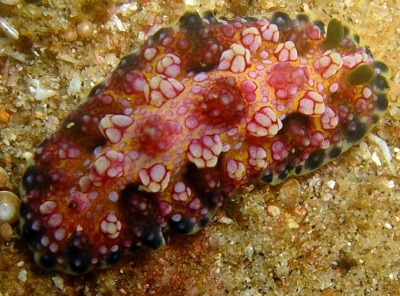
Hi Bill,
I photographed this one, but for the life of me can not figure out what it is.
Locality: Sodwana bay, 5-mile reef, 21 metres, South Africa, Indian, 17 June 2006, Rocky reef with sandy patches. Length: 30mm. Photographer: Riaan Marx.
Please assist.
Kind regards,
Riaan
rmarx@aasa.co.za
Marx, R., 2006 (Jun 26) Phyllidiopsis cardinalis from South Africa. [Message in] Sea Slug Forum. Australian Museum, Sydney. Available from http://www.seaslugforum.net/find/16963Dear Riaan,
TryPhyllidiopsis cardinalis
Best wishes,
Bill Rudman
Phyllidiopsis cardinalis from sthn Queensland
December 29, 2004
From: Gary Cobb
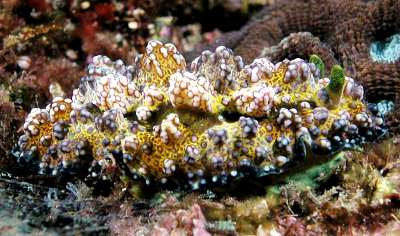
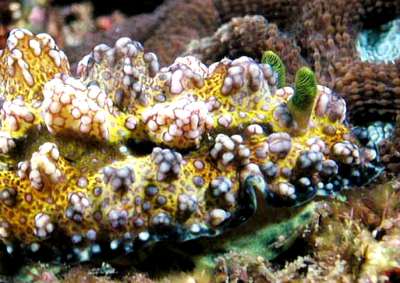
Hi Bill,
Good to see you and the Forum are BACK! Attached is an interesting critter, Phyllidiopsis cardinalis, which I thought you might like to see.
Locality: Shellacy Reef, Mooloolaba, sthn Queensland, Australia
Depth: 15 m. Length: 40 mm. 23 December 2004. on reef.
Photographer: Gary Cobb
Cheers
Gary Cobb
gary@nudibranch.com.au
Cobb, G., 2004 (Dec 29) Phyllidiopsis cardinalis from sthn Queensland. [Message in] Sea Slug Forum. Australian Museum, Sydney. Available from http://www.seaslugforum.net/find/12839Thanks Gary,
This species is probably more common than we realise, but although close-up it looks quite spectacularly coloured, when it's sitting in its normal habitat, it is remarkably well camouflaged
Best wishes,
Bill Rudman
Phyllidiopsis cardinalis? from Reunion Is
December 4, 2003
From: Yves Coze
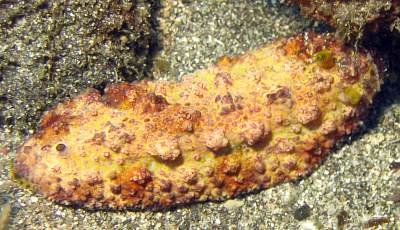
Dear Bill,
During a dive recently [November 2003] at Cap La Houssaye (10 m, Reunion Island), I spotted this nudibranch in a rocky and sandy area. It's the first time I have seen a nudibranch like this one, could you please confirm what it is.
My best guess would be Phyllidiopsis cardinalis but I'm not quite sure.
Thank's in advance
Yves Coze
info@rando-reunion.com
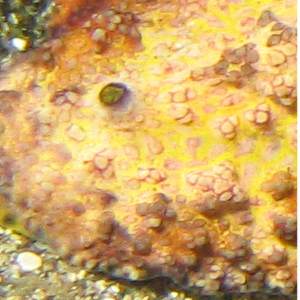
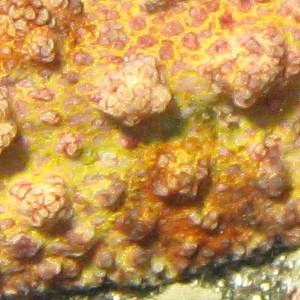
Dear Yves,
Yes this is Phyllidiopsis cardinalis. At the left end of your photo [posterior end of the animal] you can clearly see the anal opening [see lower left close-up]. One way phyllidiids differ from other dorids is that they no longer have a circle of gills around the anus. Instead they have secondary gills in the space between the side of the body and the mantle [see lower photos on Torsion and nudibranch gills page]. The lower right photo shows the shape of the mantle tubercles and the incomplete reddish reticulate pattern usually found in this species
Best wishes
Bill Rudman
Phyllidiopsis cardinalis from Indian Ocean
October 28, 2002
From: Marina Poddubetskaia
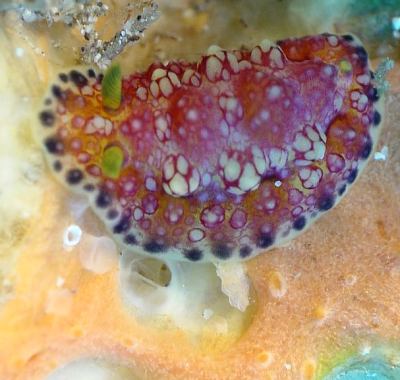
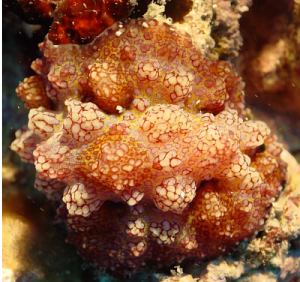
Dear Bill,
Here are some photos of Phyllidiopsis cardinalis. I found several specimens in Reunion and only one in Mauritius. All these guys were found under dead corals. All specimens I saw had green rhinophores. I think it must be one of characteristics of this species.
Upper: animal photographed on the dead coral where it was found
Date: October 09, 2002
Location: St-Leu, Reunion Island, Indian Ocean
Site: Banc de sable
Depth: 13m
Size: 15-20mm
Lower: October 18, 2002
Location: Pereybere, Mauritius, Indian Ocean
Site: Jardin de Corail
Depth: 18m
Size: 30-35mm
Photos: Marina Poddubetskaia - Nembro website
Best wishes,
Marina.
nembro@nembro.info
Poddubetskaia, M., 2002 (Oct 28) Phyllidiopsis cardinalis from Indian Ocean. [Message in] Sea Slug Forum. Australian Museum, Sydney. Available from http://www.seaslugforum.net/find/8293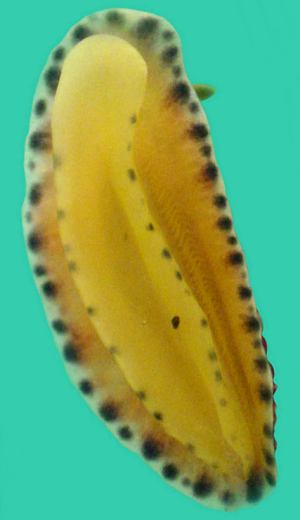
Dear Marina,
Thanks for these photos. I have put your photo of the foot and underside of the animal, showing the characteristic yellow colour here. It also shows the gills, on the animal's left side, below the mantle skirt.
St-Leu, Reunion Island, Indian Ocean. Site: Banc de sable, Depth: 13m, October 09, 2002. Size: 15-20mm.
Also of interest is the upper photo which shows the animal on a sponge rather than a dead coral. It may prove to be a useful feeding record.
Best wishes,
Bill Rudman
Phyllidiopsis sp? from Hachijo Island Japan
May 9, 2002
From: Shouichi Kato
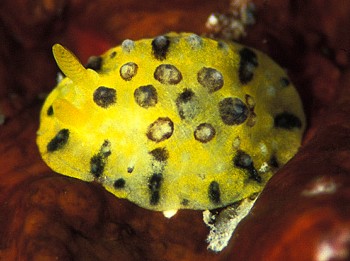
Dear Bill,
Please see am attached photo. I found this animal under a rock. I guess this animal is in the genus Phyllidiopsis because it doesn't have gills and looks rather hard. But unfortunately this animal was too small to check the position of its anus. Please give us your advice.
Depth : 40m
Size : 10mm
Hachijo Island, Japan
Best Regards,
S. Kato
regulus@edit.ne.jp
Kato, S., 2002 (May 9) Phyllidiopsis sp? from Hachijo Island Japan. [Message in] Sea Slug Forum. Australian Museum, Sydney. Available from http://www.seaslugforum.net/find/6866Dear Shouichi,
This is a juvenile, and I suspect it may be a juvenile of Phyllidiopis cardinalis. It appears to be getting some black pigmentation in the rhinophores which would cancel out another possibility, Phyllidia ocellata.
Best wishes,
Bill Rudman
Nudibranch - Southern Mozambique
April 19, 2001
From: Ian Miller
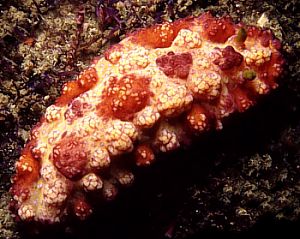
Hi Bill,
I am having some trouble identifying this nudibranch found on a recent trip to Southern Mozambique. It was on a small reef surrounded by sand at a depth of 24 m. The size is 7 cm and the my best guess from the books I have is genus Sclerodoris.
Your assistance would be greatly appreciated.
Thanks
Ian & Kirsty Miller
diverian@xsinet.co.za
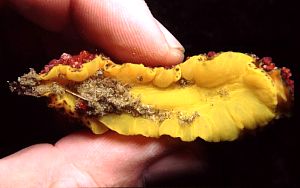
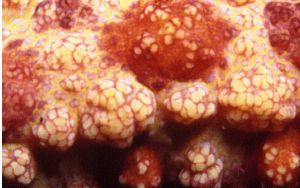
Dear Ian & Kirsty,
Your nudibranch is Phyllidiopsis cardinalis. The phyllidiids can usually be distinguished from 'normal' dorids like
Best wishes,
Bill Rudman
Phyllidiopsis cardinalis from the Solomons
February 16, 2001
From: Bruce Potter
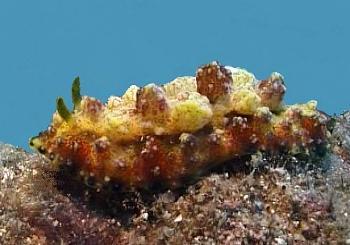
Bill,
The atached slug was filmed at about 14m, on a coral and rubble site just on the outskirts of Honiara, Solomon Islands.
It was about 30mm long. I have not been able to identify it. Can you help?
Regards,
Bruce Potter.
bruce.potter@adventist.org.sb
Potter, B., 2001 (Feb 16) Phyllidiopsis cardinalis from the Solomons. [Message in] Sea Slug Forum. Australian Museum, Sydney. Available from http://www.seaslugforum.net/find/3733Dear Bruce,
This is Phyllidiopsis cardinalis. It is certainly a change from the usual phyllidiid grey and blue
Best wishes,
Bill Rudman
Phyllidiopsis cardinalis from Thailand
February 6, 2001
From: Erwin Koehler
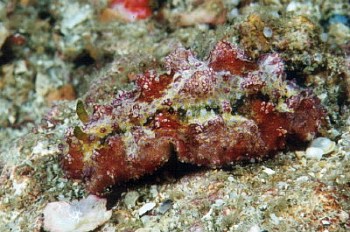
Dear Bill,
here is the next one from Thailand, Koh Ha Yai Island, depth 24m, size 53mm, Dec. 31, 2000. Is it Phyllidiopsis cardinalis?
Erwin
Medslugs.Koehler@t-online.de
Koehler, E., 2001 (Feb 6) Phyllidiopsis cardinalis from Thailand. [Message in] Sea Slug Forum. Australian Museum, Sydney. Available from http://www.seaslugforum.net/find/3659Dear Erwin,
It is. This is one of those species that looks spectacularly beautiful in a dish, but almost invisible in the field.
Bill Rudman
Phyllidiopsis cardinalis from South Africa
April 30, 2000
From: Valda Fraser
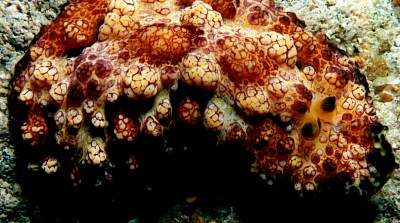
Dear Bill
What a dreadful mistake! Now we will have to make do with an incomplete animal. Do you know who he is?
Locality: South coast KwaZulu-Natal SOUTH AFRICA. Scottburgh - 15m
Date: April 2000
Size: 60mm
Thanks.
Regards
Valda Fraser
iti04937@mweb.co.za
Fraser, V., 2000 (Apr 30) Phyllidiopsis cardinalis from South Africa. [Message in] Sea Slug Forum. Australian Museum, Sydney. Available from http://www.seaslugforum.net/find/2326Dear Valda,
..... not that dreadful a mistake Valda, we can see most of the animal. It is Phyllidiella cardinalis . Quite a spectacular animal in a dish but usually very well camouflaged at home. Quite like Ceratosoma miamirana in that respect.
Best wishes,
Bill Rudman.
Phyllidiopsis cardinalis - cryptic colouration?
November 13, 1998
From: Clay Bryce
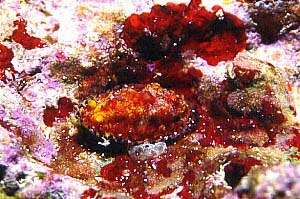
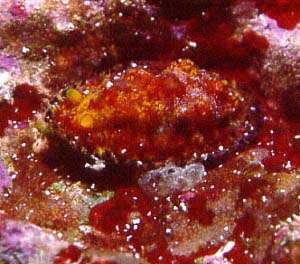
Dear Bill,
here is a photo of mine of an animal I haven't a clue about. Sclerodoris sp. perhaps? It was collected at Cartier Island, Kimberley region, northwestern Australia.
I have a few more unknowns which I will dribble to you if that's ok.
All the best,
Clay Bryce
Western Australian Museum
Perth,
WA 6000.
brycec@museum.wa.gov.au
Bryce, C., 1998 (Nov 13) Phyllidiopsis cardinalis - cryptic colouration?. [Message in] Sea Slug Forum. Australian Museum, Sydney. Available from http://www.seaslugforum.net/find/303Clay,
It is Phylidiella cardinalis which is a most "unPhyllidia" looking animal. I have wondered why it has such a peculiar colour pattern and your photo suggests a possible answer. On the original slide the reddish brown layer which the slug is on appears to be a compound ascidian with the individual zooids being edged with reddish brown..much the same colour pattern as the phyllidiid. I'm afraid only a hint of this can be seen on the enlarged scan above. It would be worth keeping a look out for this species of Phyllidiella on this colony again. Perhaps it is its food. If so, it would be a fascinating discovery to find it eating something other than a sponge, which is the supposed food of phyllidiids.
Concerning your "threat" to dribble more photos to me for the Sea Slug Forum. I am happy to receive them. If it all gets too much I can always say no, or recruit some helpers.
Best wishes,
Bill Rudman.
Phyllidiopsis from Mooloolaba
July 22, 1998
From: Wayne Ellis
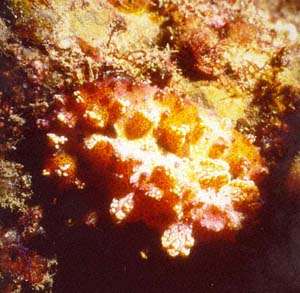
Hi Bill,
Here is another of Steve Grail's photos. It was taken off Mooloolaba, Sunshine Coast, southern Queensland, in 10-20m, between 1996 and 1998.
Regards
Wayne Ellis
glaskin@ozemail.com.au
Ellis, W., 1998 (Jul 22) Phyllidiopsis from Mooloolaba. [Message in] Sea Slug Forum. Australian Museum, Sydney. Available from http://www.seaslugforum.net/find/105This strangely-shaped phyllidiid is often found on the underside of encrusted coral boulders. Its compound tubercles make it unique in the family. The colour and shape are assumed to be for camouflage. It would be interesting to see if this species lacks the defensive chemicals found in most phyllidiids. The only other phyllidiids with tubercles are in the genus Ceratophyllidia but in that case the "tubercles" are attached to the body by short narrow stalks. If you look at Phyllidiopsis shireenae you will see that not all species in Phyllidiopsis have compound tubercles, in fact P. cardinalis is the only one. The only good external character separating species of Phyllidiopsis from other phyllidiids are their fused oral tentacles. In most phyllidiids the oral tentacles are tapering finger-like structures on each side of the mouth. In Phyllidiopsis the two tentacles are fused into a single flap. They only other genus to show any sign of fusion is Ceratophyllidia in which the base of the tentacles are fused.
Bill Rudman
